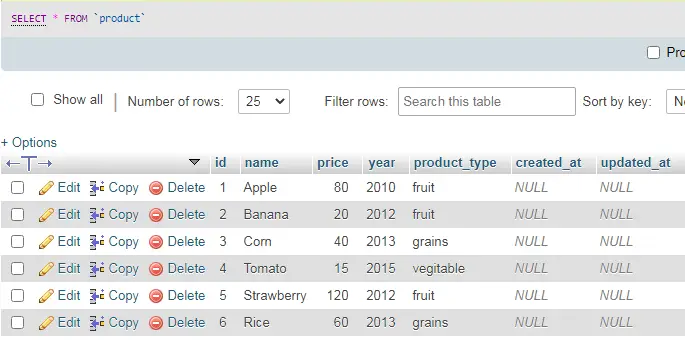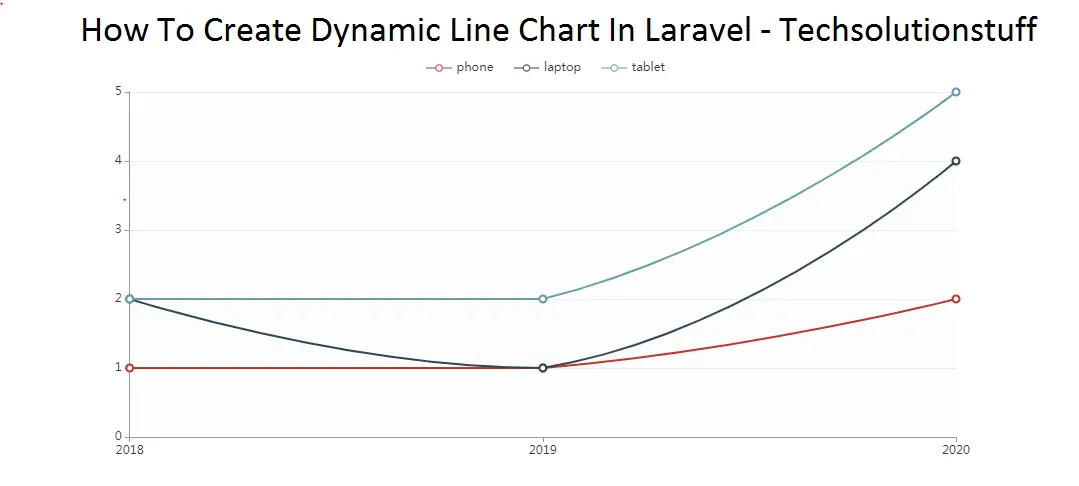How To Create Dynamic Line Chart In Laravel
In this tutorial we will see how to create dynamic line chart in laravel. A dynamic line chart or line plot or line graph or curve chart is a type of chart which displays information as a series of data points called 'markers' connected by straight line segments. It is a basic type of chart common in many fields.
For creation of dynamic linechart example you need to create route, controller, blade file and database, So if you will follow my tutorial step by step then definitely you will get output.
let's start to implement line chart in laravel step by steps.
Type the following command in terminal to install new project in laravel.
composer create-project --prefer-dist laravel/laravel linechart
We are getting dynamic data for linechart example. So, we need to create migration for "product" table using Laravel php artisan command.
php artisan make:migration create_products_table --create=products
After run this command you will find php file in this location "database/migrations/" in this file you need to add below code.
<?php
use Illuminate\Database\Migrations\Migration;
use Illuminate\Database\Schema\Blueprint;
use Illuminate\Support\Facades\Schema;
class CreateProductsTable extends Migration
{
public function up()
{
Schema::create('products', function (Blueprint $table) {
$table->id();
$table->string('name')->nullable();
$table->integer('price')->nullable();
$table->integer('year')->nullable();
$table->string('product_type')->nullable();
$table->timestamps();
});
}
public function down()
{
Schema::dropIfExists('products');
}
}
after this we need to run this migration by following command in our terminal:
php artisan migrate
And after migration you need to add some records as per below screen print.

Now add route in Routes/web.php
Route::get('linechart', 'LinechartController@linechart');
After adding route we need to create new controller and model for linechart example.So, type below command in your terminal for create controller.
php artisan make:controller LinechartController
php artisan make:model Product
Now add below code in your linechartcontroller.
<?php
namespace App\Http\Controllers;
use Illuminate\Http\Request;
use App\Product;
class LinechartController extends Controller
{
public function linechart(Request $request)
{
$phone_count_18 = Product::where('product_type','phone')->where('year','2018')->get()->count();
$phone_count_19 = Product::where('product_type','phone')->where('year','2019')->get()->count();
$phone_count_20 = Product::where('product_type','phone')->where('year','2020')->get()->count();
$laptop_count_18 = Product::where('product_type','laptop')->where('year','2018')->get()->count();
$laptop_count_19 = Product::where('product_type','laptop')->where('year','2019')->get()->count();
$laptop_count_20 = Product::where('product_type','laptop')->where('year','2020')->get()->count();
$tablet_count_18 = Product::where('product_type','tablet')->where('year','2018')->get()->count();
$tablet_count_19 = Product::where('product_type','tablet')->where('year','2019')->get()->count();
$tablet_count_20 = Product::where('product_type','tablet')->where('year','2020')->get()->count();
return view('linechart',compact('phone_count_18','phone_count_19','phone_count_20','laptop_count_18','laptop_count_19','laptop_count_20','tablet_count_18','tablet_count_19','tablet_count_20'));
}
}
In last we are creating blade file for view output of line chart, So copy below code in your linechart.blade.php file.
<!DOCTYPE html>
<html>
<head>
<meta charset="utf-8">
<meta http-equiv="X-UA-Compatible" content="IE=edge">
<title>How To Create Dynamic Line Chart In Laravel - techsolutionstuff.com</title>
<link rel="stylesheet" href="https://maxcdn.bootstrapcdn.com/bootstrap/3.3.7/css/bootstrap.min.css">
<link href="{{asset('assets/css/components.min.css')}}" rel="stylesheet" type="text/css">
<script type="text/javascript" src="{{asset('assets/js/jquery.min.js')}}"></script>
<script type="text/javascript" src="{{asset('assets/js/bootstrap.bundle.min.js')}}"></script>
<script type="text/javascript" src="{{asset('assets/js/echarts.min.js')}}"></script>
</head>
<body>
<div class="col-md-12">
<h1 class="text-center">How To Create Dynamic Line Chart In Laravel - techsolutionstuff.com</h1>
<div class="col-md-8 col-md-offset-2">
<div class="col-xl-6">
<div class="card">
<div class="card-body">
<div class="chart-container">
<div class="chart has-fixed-height" id="line_stacked"></div>
</div>
</div>
</div>
</div>
</div>
</div>
</body>
</html>
<script type="text/javascript">
var line_stacked_element = document.getElementById('line_stacked');
if (line_stacked_element) {
var line_stacked = echarts.init(line_stacked_element);
line_stacked.setOption({
animationDuration: 750,
grid: {
left: 0,
right: 20,
top: 35,
bottom: 0,
containLabel: true
},
legend: {
data: ['phone', 'laptop', 'tablet'],
itemHeight: 8,
itemGap: 20
},
// Add tooltip
tooltip: {
trigger: 'axis',
backgroundColor: 'rgba(0,0,0,0.75)',
padding: [10, 15],
textStyle: {
fontSize: 13,
fontFamily: 'Roboto, sans-serif'
}
},
xAxis: [{
type: 'category',
boundaryGap: false,
data: [
'2018', '2019', '2020'
],
axisLabel: {
color: '#333'
},
axisLine: {
lineStyle: {
color: '#999'
}
},
splitLine: {
lineStyle: {
color: ['#eee']
}
}
}],
// Vertical axis
yAxis: [{
type: 'value',
axisLabel: {
color: '#333'
},
axisLine: {
lineStyle: {
color: '#999'
}
},
splitLine: {
lineStyle: {
color: ['#eee']
}
},
splitArea: {
show: true,
areaStyle: {
color: ['rgba(250,250,250,0.1)', 'rgba(0,0,0,0.01)']
}
}
}],
// Add series
series: [
{
name: 'phone',
type: 'line',
stack: 'Total',
smooth: true,
symbolSize: 7,
data: [{{$phone_count_18}},{{$phone_count_19}},{{$phone_count_20}}],
itemStyle: {
normal: {
borderWidth: 2
}
}
},
{
name: 'laptop',
type: 'line',
stack: 'Total',
smooth: true,
symbolSize: 7,
data: [{{$laptop_count_18}},{{$laptop_count_19}},{{$laptop_count_20}}],
itemStyle: {
normal: {
borderWidth: 2
}
}
},
{
name: 'tablet',
type: 'line',
stack: 'Total',
smooth: true,
symbolSize: 7,
data: [{{$tablet_count_18}},{{$tablet_count_19}},{{$tablet_count_20}}],
itemStyle: {
normal: {
borderWidth: 2
}
}
}
]
});
}
</script>
After follow all steps you will get output like below screen print.

You might also like :
- Read Also : Laravel 8 Google Recaptcha Example
- Read Also : Laravel Datatable Example Tutorial
- Read Also : How To Increase Session Lifetime In Laravel
- Read Also : Google Map With Draggable Marker Example








